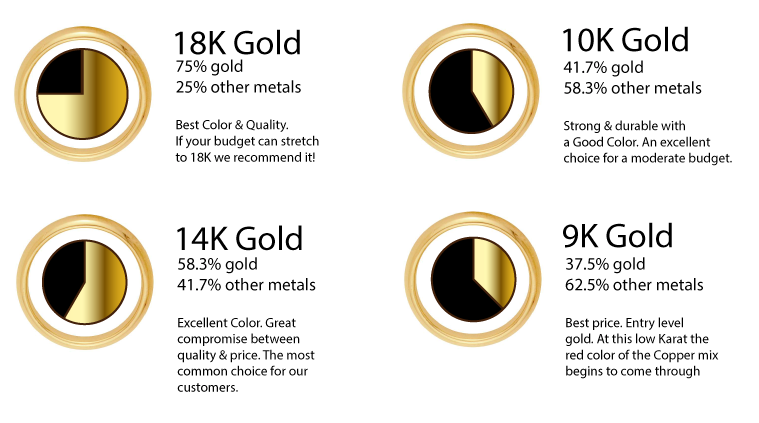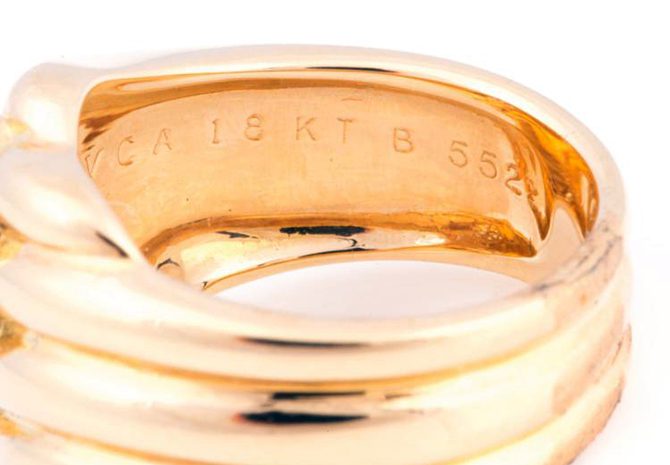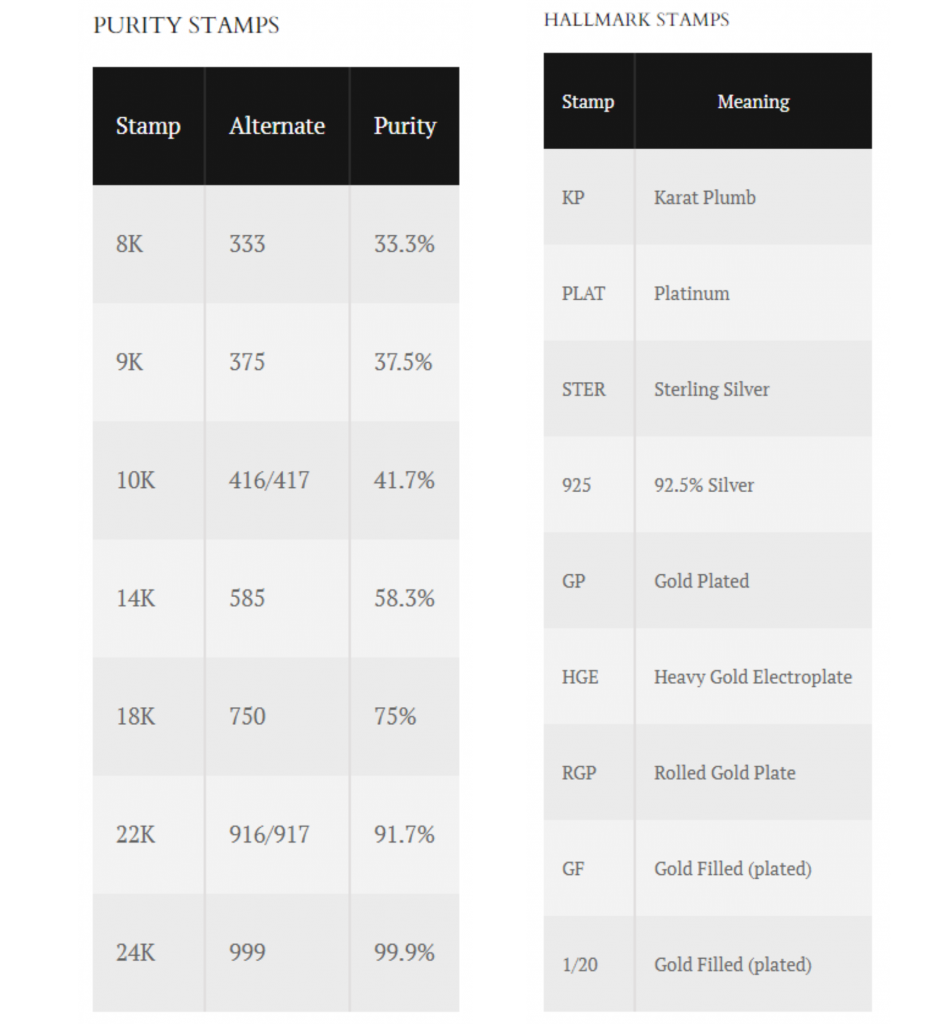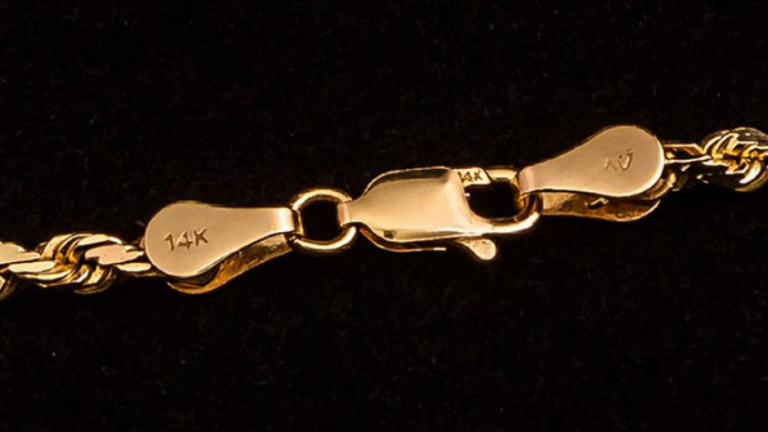What’s the value of your gold jewelry? It sounds like a daunting task. But, it turns out that you don’t need to be an expert in order to assess where pieces come from or their worth. All you have to do is know some simple terms and follow a few steps! First off, what are these “gold stamps?”
What does the 10K/14K/18K Stamp Mean? Understanding Gold Purity and Value
You’ve been meaning to assess the value of your gold jewelry collection, but it’s always sounded intimidating. You inherited most of the pieces from your grandmother, and you have no idea where she got them. Are they priceless heirlooms, cheap knockoffs, or somewhere in between? Fear not, deciphering the purity and value of your gold is very doable. Here’s an overview of gold stamps, purity, and value.
Understanding Karats
You probably already know that the more karats a gold piece has, the more valuable it is. The number of karats refers to the portion of the piece that is pure gold, with 100% pure gold being 24 karats. This means that a 14 karat piece would be 58.3% pure gold, since 14 divided by 24 is .583. The remaining 41.7% of the piece is composed of other metals, like copper, nickel, silver, or palladium. An understanding of karats is key to deciphering the purity and value of your gold.

Reading Karat Stamps
Once you have a basic understanding of karats, you can examine your gold for stamps. Stamps are markings on your pieces. On rings, the markings are often on the inside of the ring, and on chains, the mark is often on the clasp or right next to the clasp. By law, gold jewelry sold by a vendor must have a stamp of the piece’s purity, so finding a stamp is a good sign! If you can’t find a stamp, it’s possible it wore off with time, or was sold before the law was passed. Don’t worry if there is no stamp to be found, you can always consult an expert! Gold buyers have significant experience in deciphering value, and can also provide advanced tests to determine gold purity.

Even when you’ve found a stamp, you may still be confused. Some stamps are straightforward, containing a number followed by ‘K’ to indicate the number of karats. The most common such markings are 10K, 14K, and 18K. 12K is very uncommon, and can often indicate less valuable gold-filled jewelry.
There are many other stamps that indicate valuable jewelry that are not as straightforward as ‘K’ marks. Sometimes, a piece will be stamped with 3 numbers instead of a ‘K’ stamp. This is simply another way to indicate a gold piece’s purity, and has an equivalent meaning to ‘K’ marks. The three numbers represent the percentage purity. For example, the marking ‘417’ means 41.7% gold, which is 10 karats. Using this same format, 14 karat pieces are marked ‘583’ (sometimes ‘585’) and 18 karat pieces are marked ‘750,’ and so on.

Other Stamps
Karat markings are often followed by letters, which can have large implications for both the purity and value of your gold. There are a variety of these markings, and if you’re at all unsure about your piece, it’s a good idea to consult an expert to make sure you’re interpreting your stamps correctly.
A karat marking followed by ‘P’ indicates that the piece is plumb, meaning the purity is exact. For example, ‘10KP’ is exactly 41.7% gold. Federal law allows the stamp to deviate .5 karats from the exact purity, so a ‘10K’ stamp could be as low as 9.5 karats, but the plumb stamp guarantees the exact 41.7%.
Most other letter markings indicate that a piece is gold-plated or gold-filled. Gold-plated pieces may be marked ‘GP,’ ‘GE,’ or ‘HGE.’ ‘GP’ or ‘GE’ means the piece is electroplated with a thin layer of gold; ‘18K GP’ would indicate a piece plated with 18 karat gold. ‘HGE’ can stand for both ‘Heavy Gold Electroplate’ or ‘High Grade Electroplate,’ meaning the piece is gold-plated with a slightly thicker layer than a GP or GE piece. Unfortunately, this pieces typically have little value since they have little gold content.
A ‘GF’ stamp means the piece is gold-filled, and a ‘RGP’ stamp means the piece is coated in a rolled gold plate. Like gold-plated stamps, these stamps may come after a karat stamp. In these pieces, the gold is bonded to the surface of a base metal, and typically contain more gold than a plated piece, but still not solid gold. Gold-filled stamps may include a fraction like ‘1/10 10K GF,’ meaning that 10% of the weight of the piece is 10 karat gold. Gold-filled items are often more valuable than gold-plated pieces, but still contain significantly less gold than pure gold pieces.
Now that you can read the stamps on your pieces, hopefully the confusion of evaluating your collection is gone! We wish you the best of luck in assessing your pieces. Remember, you can always stop in to one of our locations if you have any questions!


